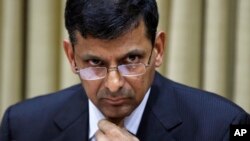India's central bank unexpectedly lowered its policy rate for the second time this year on Wednesday, backing a government that is pushing to revive economic growth as inflation cools.
Although markets had broadly expected the Reserve Bank of India (RBI) to reduce rates again after a cut in January, few had expected a move just days after the government unveiled a budget that took a slower path to lowering the fiscal deficit.
“Given low capacity utilization and still-weak indicators of production and credit off-take, it is appropriate for the Reserve Bank to be pre-emptive in its policy action to utilize available space for monetary accommodation,” RBI Governor Raghuram Rajan said in a statement.
Rajan aired doubts over the credibility of official data after recent changes to methodology showed India's economy grew 7.5 percent in the last quarter, faster than China.
“Nevertheless, the picture of a steadily recovering economy appears right,” he said.
The RBI had first lowered interest rates this year on Jan. 15, in a similarly unexpected move that signaled the start of a new easing cycle. Both rate cuts took place outside of the central bank's scheduled policy review meetings.
The benefits have still to pass through to borrowers, however, as commercial banks have been hesitant about lowering their lending rates.
Analysts said the latest rate reduction showed the RBI's trust in the 10-month-old government of Prime Minister Narendra Modi to maintain fiscal discipline even though it will take longer to reach its deficit goals.
“The Reserve Bank of India is expressing its confidence on the inflation outlook,” said Radhika Rao, economist at DBS. “This also means that despite a higher fiscal deficit, the quality of fiscal consolidation has satisfied central bank expectations.”
The budget laid out plans to reduce the fiscal deficit to 3.9 percent of gross domestic product in the 2015/16 financial year and bring it down to 3.0 percent by 2017/18 - a year later than an earlier road map had targeted.
Describing the deficit reduction plan as “very prudent,” junior finance minister Jayant Sinha said the government was striking a balance between making more gradual reductions in the deficit and investing in infrastructure and key sectors.
“It's that balance that the RBI has appreciated,” Sinha said, responding to the interest rate cut.
The boost for the government also comes a week after it endorsed an RBI-led change to monetary policy, formally adopting inflation targeting. India is expected to establish a monetary policy committee, which could give the government more influence over decisions like interest rate moves, but its size and composition remain a matter of heated debate on both sides.
Step by step
Indian bonds rose sharply after the cut. The benchmark 10-year bond yield dropped to as much as 7.61 percent, its lowest level since July 2013.
Yet while Rajan signaled he was optimistic inflation would remain contained and analysts said they continued to expect further monetary easing, most cautioned that the prospect of deep, fast cuts was now reduced.
Indian inflation has moderated sharply as global oil prices have slumped since last year. In January, consumer prices rose an annual 5.11 percent, having fallen from double digit levels posted as recently as November 2013.
That puts inflation well within a target of 4 percent, with a band of plus or minus 2 percentage points, agreed by the RBI and the government, for the financial year beginning in April 2016.
Rajan said in the statement the RBI would seek to bring the inflation rate to 4 percent, the midpoint of that band by the end of the two-year period starting in 2016/17.
He said, however, that there were uncertainties including a potential recovery in oil prices.
India's rate cut comes as a slew of central banks across developed and emerging economies cut interest rates, including in Indonesia and China, despite the prospect of rising U.S. interest rates later this year.
Rajan's statement noted that the rupee's relative strength added to disinflationary pressures, but again warned that global events could reverse the trend.






